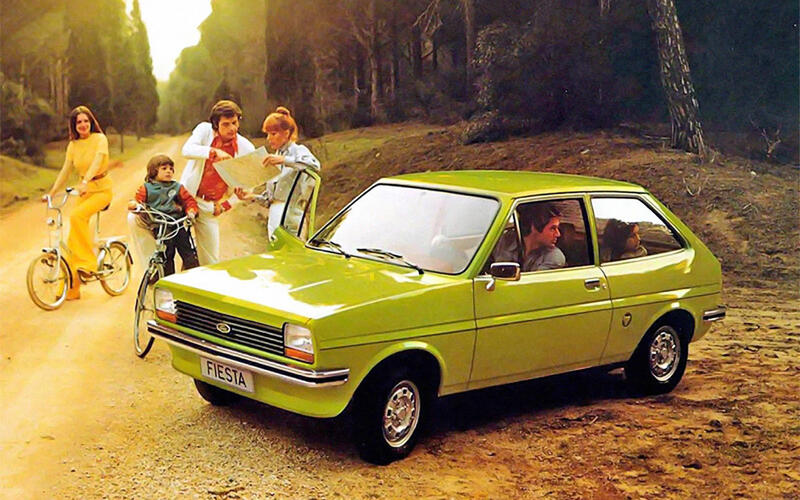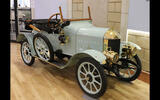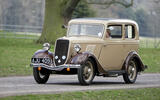 Slide of
Slide of
It’s reckoned there are around 1.6 billion cars in use around the world, with around 80 million new cars being built every year.
Model cycles are getting shorter and the choice much wider, with competition in the marketplace hotter than ever. But it didn’t used to be like that; there was a time when cars remained in production for years and years, as long as they were cheap and reasonably dependable, notching up big sales in the process. Here we celebrate the cars that gave us independence, the models that put the world on wheels:
 Slide of
Slide of
Ford Model T (1908)
Nicknamed the Tin Lizzie, this was the car that put America on wheels. Over 15 million were made and at one point, half of all the cars in the US were Model Ts thanks to the efficiency of mass production. It was built all the way through to 1927, by which time it was being outpaced by newer competitors. But not before it made Henry Ford one of the richest men in the world.
 Slide of
Slide of
Morris Bullnose (1913)
Officially sold as the Oxford, in recognition of the British city in which it was made, the Bullnose featured a 1.0-litre side-valve engine. By 1925, almost half of the cars sold in the UK were Bullnoses, and helped make William Morris the English version of Henry Ford in terms of his impact and wealth.
 Slide of
Slide of
Austin Seven (1922)
There was something for everyone in the Seven range, with an astonishing 326 variants offered over nearly two decades of production. British firm Austin made fewer than 300,000 in total – but most importantly, this was a car that 'normal' people could afford to buy.
 Slide of
Slide of
Ford Model Y (1932)
Produced in numerous countries worldwide, the Model Y was also known as the Ford 8 in the UK, where it dominated the marketplace.
 Slide of
Slide of
Fiat Topolino (1936)
Fiat's answer to the Austin Seven of the 1920s, the original 500 (nicknamed Topolino, or Mickey Mouse) could seat just two and was powered (if that's the right word) by a tiny side-valve engine good for 13bhp. It was also sold as a Simca in France. A cool 520,000 were made until 1955.
 Slide of
Slide of
Volkswagen Beetle (1945)
First unveiled before the Second World War as 'the strength through joy car' to put Nazi Germany on wheels, production of this ultimate cult car only properly got going after it, with the friendlier post-war name of Volkswagen ('People's Car').
More than 21 million examples of the air-cooled Beetle rolled off the production lines over more than half a century. An all-new Golf-based edition arrived before the old one had even gone.
 Slide of
Slide of
Renault 4CV (1946)
Effectively a French Beetle, the rear-engined 4CV was developed secretly during the German occupation, and after the war offered perfect cheap transport for the masses in a country that was very short of cars: the Germans had stolen most of them. A variety of models was offered, and 1.1 million were made in all over 15 years. By the end, 21bhp in power was on offer.
 Slide of
Slide of
Citroen 2CV (1948)
While the 4CV was being covertly developed, so Renault's cross-town rivals at Citroen were doing the same with the 2CV. The company's boss requested a car that "replaces the bicycle, the motorcycle and the horse-drawn carriage.” His engineers delivered. One of the most recognisable shapes ever, this was a true people’s car as it was stripped to the max in a bid to reduce costs and was extremely simple to maintain.
Production lasted over 40 years, with around four million built.
 Slide of
Slide of
Morris Minor (1948)
One of the all-time greats, the Minor was the first British car to sell a million. It came in Traveller (estate), Tourer (convertible) and saloon forms, while there were also van and pick-up editions too. Production lasted until 1971.
 Slide of
Slide of
Standard Eight (1953)
When it came to basic motoring, few cars were as stripped-out as this British one in a bid to keep costs down in the austere post-war years (food rationing only ended in Britain in 1954). Early cars didn't even feature a boot lid - the rear seats had to be tipped forward to access the luggage bay. But it was cheap and surely better than walking.
 Slide of
Slide of
BMW Isetta (1955)
Developed by Italian supercar maker Iso, this tiny BMW's name was derived from the Italian for 'baby Iso' thanks to its diminutive size. Open and closed cars were offered, and helped to keep BMW in business at a time when it was in danger of collapsing.
 Slide of
Slide of
Renault Dauphine (1956)
Like the 4CV, the Dauphine was a rear-engined cheap car that offered space and comfort and surprising innovation. However, few of the 2.2 million made have survived, most having rusted away.
 Slide of
Slide of
Fiat 500 (1957)
Italy’s take on the economy car; a rear-mounted air-cooled 13 hp 499cc engine, seating for four and all-round independent suspension. 300 or so examples even made it to America in the early '60s, where driving this tiny car among the vast homegrown models of the time must have been... an experience. Produced until 1975, 3.9 million 500s were built, and truly helped put Italy on the road.
 Slide of
Slide of
Daf Daffodil (1958)
The Dutch attempt at changing the motoring landscape wasn't entirely successful, but it did leave its mark thanks to its innovative Continuously Variable Transmission (CVT) gearbox, as used in the Prius you used last night from Uber.
 Slide of
Slide of
Austin Healey Sprite (1958)
Impoverished students everywhere could rejoice with the arrival of this one; a sports car for the masses. Fewer than 50,000 were made, but it was affordable at a time when any car at all was still very much a luxury for the vast majority of people.
 Slide of
Slide of
Austin/Morris Mini (1959)
Modern regulations mean we'll never see its like again; this is perhaps the all-time packaging great – 80% of its volume was habitable. It was also the first truly classless car. 5.3 million Minis had found homes in the UK and far beyond when production ended in 2000.
 Slide of
Slide of
Triumph Herald (1959)
A favourite with British driving schools thanks to its great visibility and light controls, the Herald was made in convertible, saloon, coupe, estate and van guises along with the sporty Vitesse edition. A cool 521,000 Heralds were made.
 Slide of
Slide of
Renault 4 (1961)
Few classic enthusiasts would have a 4 at the top of their wish list, but with eight million built you can't deny its popularity. Renault's first front-wheel drive car, production lasted until 1992.
 Slide of
Slide of
MG B (1962)
At one point this was the world's best-selling sports car, thanks to a lifespan of almost two decades and popularity in the US. Open (Roadster) and closed (GT) editions were offered, the latter in V8 form, briefly.
 Slide of
Slide of
Austin/Morris 1100/1300 (1962)
In a production run that spanned more than a decade, over a million of these cars were made, and was Britain's best-selling car for much of its life. Spacious and comfortable, this was another Issigonis masterpiece, with Mini-like packaging.
 Slide of
Slide of
Ford Cortina (1962)
The quintessential Sixties sales rep special in Europe, the Cortina went on to become an icon thanks to massive sales figures and plenty of high-profile motorsport successes, usually by Lotus-tuned examples. Five generations were produced until 1982, but the first was designed by Roy Brown Jr, designer of the Edsel.
 Slide of
Slide of
Vauxhall Viva (1963)
Rarely a car to quicken the pulse, the Viva was made in three distinct generations, offering cheap and practical transport for the masses. Early cars were very basic; later ones much better. The Viva badge was later revived by Vauxhall, which was GM’s British brand until it was sold to France’s PSA in 2017, and is now part of Stellantis.
 Slide of
Slide of
Hillman Imp (1963)
One of the few cars that could give the Mini a run for its money dynamically, the Imp was blighted by poor reliability in the early days. The problems were fixed, but sadly, the reputation stuck. 440,032 were built, mostly at a factory near Glasgow.
 Slide of
Slide of
Fiat 850 (1964)
Offered in popular spider and coupé guises, it's the saloon which accounted for most of the 2.2million+ sales over eight years of production. It's largely forgotten now though, even in Italy.
 Slide of
Slide of
Ford Mustang (1964)
Nobody could have predicted how popular the Mustang would be. With over a million sold in the first two years, this would be America's fastest-selling car, thanks to a multitude of options and competitive pricing. The seventh generation continues the theme, and it's the world's best selling sports car today. Over 10.2 million examples have been produced, and it's one of the very few Ford-badged passenger cars left, as the brand has largely left the class in favour of SUVs and pickups.
 Slide of
Slide of
Fiat 124 (1966)
Although just over two million Fiat 124s were built, it’s claimed that as many as 17 million more were made wearing (Russian) Lada badges. That would make it the second biggest-selling car of all time, after the original VW Beetle. Extremely simple, they were at least easy to maintain. Heavy (and obviously unpowered) steering meant they were not the easiest cars to pilot.
 Slide of
Slide of
Toyota Corolla (1966)
One of the least exciting cars ever designed, the Corolla has still managed to clock up over 40 million sales thanks to production spanning 11 generations and more than half a century. The current model is one of the best in its class today.
 Slide of
Slide of
Ford Escort (1968)
Ford used the same formula for its Escort as for the Cortina - a version for everyone, masses of motorsport success and low purchase prices. Sporty editions are now more collectable than ever The nameplate in Europe ended with the unloved Mk5, on which Ford apparently spent £1 billion to develop, though quite how we're not sure. 4.1 million Escorts were made before the nameplate gave way to the Focus in 1998.
 Slide of
Slide of
Jaguar XJ (1968)
Is it a people’s car? Definitely; the XJ brought luxury to the masses, as it offered all the Jaguar attributes of grace, pace and space at a cost far lower than any rivals. It was the best selling luxury car in the UK for most of the '70s and '80s, but the Germans upped their game and gradually supplanted it in boardroom car parks. Production ended in 2018, but the name was to be revived for an all-electric model; that was mysteriously cancelled in early 2021, shortly before it was due to be unveiled.
 Slide of
Slide of
Peugeot 504 (1968)
Africa is still full of 504 estates and pick-ups, largely because this tough and practical car was built there until relatively recently; production only ended in Nigeria in 2006. Rarer and more collectible are the coupé and cabrio editions, the latter of which is marvellously handsome.
 Slide of
Slide of
Ford Pinto (1970)
An economy car for the masses, the Pinto would go on to gain a terrible reputation for exploding in the event of a rear impact. Despite this - and helped by the fact that it was keenly priced and economical at a time when fuel prices were going through the roof - a cool 3.2 million were sold until production ended in 1980.
 Slide of
Slide of
Fiat 127 (1971)
Now largely forgotten sadly, the 127 was Car of the Year in 1972. The 127 was built in Spain and South America and on top of the 3.7 million 127s built, there were many more (Spanish) Seat and (Yugoslavian) Zastava examples made too.
 Slide of
Slide of
Fiat 126 (1972)
Little more than a rebodied 500 – at least at first – the 126 never really got the juices flowing like its predecessor did, even though it sold in bigger numbers. Almost 4.7 million were made, including Seat and Zastava editions.
 Slide of
Slide of
Honda Civic (1972)
It started out as basic transport for the masses, but the Civic has become a luxurious and relatively costly small hatch. Now in tenth-generation form, over 20 million Civics have been sold, and it's consistently one of the best selling cars in the US.
 Slide of
Slide of
Renault 5 (1972)
Another smash hit for Renault, around 5.5 million were made in just a dozen years. Most were utilitarian runabouts, but there were fabulously sporty editions too, including the mid-engined Turbo 2. Truly a first car for many a Frenchman and woman - and far beyond too. In 2024 the Renault 5 name was revived, this time for a small and affordable electric car.
 Slide of
Slide of
Volkswagen Golf (1974)
Replacing the Beetle would never be easy, but VW pulled it off thanks to a great Giugiaro design. With great packaging, a wide engine choice but spartan kit levels, the car was a smash. Now in its eighth generation, it is consistently one of the best-selling family hatchbacks across Europe to this day.
 Slide of
Slide of
Volkswagen Polo (1975)
Following on from the Passat, Golf and Scirocco, the Polo proved another hit for VW thanks to its strong build quality and unburstable engines. The Polo started out as the Audi 50 but was rebadged a VW when Audi decided to move upmarket.
 Slide of
Slide of
Ford Fiesta (1976)
When Henry Ford II was approached to fund the development of a new small car for Europe, he was said to have harrumphed "small cars, small profits." But he signed it off anyway, and Ford's first attempt at a car with a tranvserse engine and front-wheel drive proved to be a smash hit, especially once the sporty editions started to arrive.
It was Britain's best-selling car every year between 2009 and 2020, but the microchip shortage toppled it in 2021. Over 22 million Fiestas have been produced so far, but sadly the model ended production in Cologne, Germany, in July 2023. The days of a Ford being so many people's first car may be coming to an end.
 Slide of
Slide of
Vauxhall Astra (1979)
Ford had the Escort and Vauxhall countered it with this, also sold as the Opel Kadett across Europe. Now virtually extinct, the only editions worth saving are the early GTEs, built to take on the Ford Escort XR3i.
 Slide of
Slide of
Toyota Camry (1982)
Although the car never really took off in Europe, thanks to large American sales the Camry is one of the world's best-selling models with more than 21 million examples sold so far. It still sells well in America, at a time when the Big 3 have largely given up on the sedan class.
 Slide of
Slide of
Fiat Uno (1983)
With more than nine million sold, the Uno proved to be a worthy successor to the ancient 127. Car of the Year in 1984, the Uno set a trend for cars with a small footprint but a high roof line. And yet another reminder that when it comes to small cars, Fiat knows its stuff.
 Slide of
Slide of
Opel Corsa (1983)
Another driving school favourite across Europe, the Corsa replaced the Kadett, or Vauxhall Chevette in the UK. The first Corsas were sold as Novas by Vauxhall in the UK; in Australia the car sported Holden badging.
 Slide of
Slide of
Peugeot 205 (1983)
Surely the European car of the 1980s, the 205 still looks great even now, and survives in large numbers across France. Designed by Pininfarina, the 205 was in production for nearly 15 years. Production totalled over 5.2 million cars.
 Slide of
Slide of
Ford Taurus (1986)
With over seven million sold, the Taurus has been big news for Ford; for a time it was also badged as the Mercury Sable. But the large sedan segment has been murdered by the SUV in the US, and US production ended in 2019, with no replacement. However, the Taurus continues to be sold in the middle east - it's a re-badged Mondeo, a model that's still made in China.
 Slide of
Slide of
Peugeot 405 (1987)
With production hovering around the five million mark, the 405 is still being built in Egypt and Iran. It’s also been produced in Malaysia, Taiwan, Poland, Indonesia and Zimbabwe among others.
 Slide of
Slide of
Mazda MX-5/Miata (1989)
The MX-5 (known as Miata in America) proves that you don’t need lots of power or luxury to have enormous fun. More than a million MX-5s have been built across the four generations so far, successfully reviving the spirit of open-top MGs of the 1960s - but with Japanese reliability.
 Slide of
Slide of
Renault Clio (1992)
Although the original Clio was popular, it was the second-generation model of 1998 that went stellar, with almost 5.4 million made in factories across France and South America.
 Slide of
Slide of
Fiat Punto (1993)
It's easy to forget the importance of many of Fiat's small cars; the Punto racked up around nine million sales across three generations until 2018.
 Slide of
Slide of
Ford Focus (1998)
One of the most familiar shapes on the roads today, the Focus was pretty daring when unveiled in 1998. It was a huge leap forward over the horribly outdated Escort Mk5, featuring sophisticated suspension that gave the car great handling - and Ford was rewarded with big sales that continue to this day, the model now in its fourth generation.
 Slide of
Slide of
Peugeot 206 (1998)
With more than nine million sold, the 206 is Peugeot’s biggest-selling car ever. It’s been produced in a variety of countries such as Chile, Indonesia and China, and it's still being churned out in Iran.
Include in Apple News:






































































































